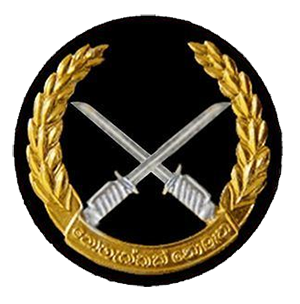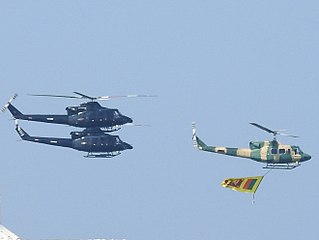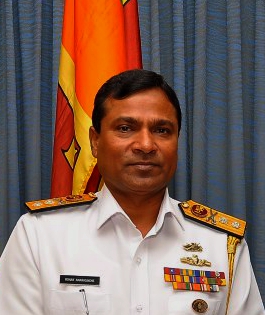
Lieutenant General Denzil Lakshman Kobbekaduwa, RWP, RSP, VSV, USP was a senior Sri Lankan Army officer who served in the 1971 Insurrection and the Sri Lankan Civil War.

The Sri Lanka Air Force is the air arm and the youngest of the Sri Lanka Armed Forces. It was founded in 1951 as the Royal Ceylon Air Force (RCyAF) with the assistance of the Royal Air Force (RAF). The SLAF played a major role throughout the Sri Lankan Civil War. The SLAF operates more than 160 aircraft.

Operation Poomalai, also known as Eagle Mission 4, was the codename assigned to a mission undertaken by the Indian Air Force for airdropping supplies over the besieged city of Jaffna in Sri Lanka on 4 June 1987 to support the Tamil Tigers during the Sri Lankan Civil War.
The Jaffna University Helidrop was the first of the operations launched by the Indian Peace Keeping Forces (IPKF) aimed at disarming the Liberation Tigers of Tamil Eelam (LTTE) by force and capturing the city of Jaffna, Sri Lanka, in the opening stages of Operation Pawan during the Indian intervention in the Sri Lankan Civil War. Mounted on the midnight of 12 October 1987, the operation was planned as a fast heliborne assault involving Mi-8's of the No.109 Helicopter Unit, the 10th Para Commandos and a contingent of the 13th Sikh Light Infantry. The aim of the operation was to capture the LTTE leadership at Jaffna University building which served as the Tactical Headquarters of the LTTE, which was expected to shorten Operation Pawan, the battle for Jaffna. However, the operation ended disastrously, failing to capture its objectives due to intelligence and planning failures. The heli-dropped force suffered significant casualties, with nearly the entire Sikh LI detachment of twenty-nine troops, along with six Para commandos, killed in action.
Operation Pawan was the code name assigned to the operation by the Indian Peace Keeping Force (IPKF) to take control of Jaffna from the Liberation Tigers of Tamil Eelam (LTTE), better known as the Tamil Tigers, in late 1987 to enforce the disarmament of the LTTE as a part of the Indo-Sri Lanka Accord. In brutal fighting lasting about three weeks, the IPKF took control of the Jaffna Peninsula from the LTTE, something that the Sri Lankan Army had tried but failed to do. Supported by Indian Army tanks, helicopter gunships and heavy artillery, the IPKF routed the LTTE at the cost of 214 soldiers and officers.

The Commando Regiment is the commando formation of the Sri Lanka Army. The unit specializes in various roles including hostage rescue, counter-terrorism, unconventional warfare, special reconnaissance, counter-insurgency, and personnel recovery. It was formed in 1980 and is based in Ganemulla, a suburb of Colombo.

The Tamil Eelam Air Force or Sky Tigers was the air service branch of the Divisions of the Liberation Tigers of Tamil Eelam, who used it against the Government of Sri Lanka. They also called themselves the Tamileelam Air Force (TAF). Though the existence of the Sky Tigers had been the subject of speculation for many years, the existence of the wing was only revealed after an attack in March 2007, during Eelam War IV.
Air Commodore Shirantha Goonetileke RWP, RSP, SLAF was a Sri Lankan aviator and the most senior Air Force officer to be killed in action. He was the youngest son of Air Chief Marshal Harry Goonatilake the 5th Commander of the Air Force and the brother of the 12th Commander of the Air Force, Marshal of the Air Force Roshan Goonetileke.
Operation Liberation also known as the Vadamarachchi Operation was the military offensive carried out by the Sri Lankan Armed Forces in May and June 1987 to recapture the territory of Vadamarachchi in the Jaffna peninsula from the LTTE. At the time it was the largest combined services operation undertaken by the armed forces deploying multiple brigade-size formation, becoming the first conventional warfare engagement on Sri Lankan soil after the end of British colonial rule. The operation involved nearly 4,000 troops, supported by ground-attack aircraft, helicopter gunships and naval gun boats. The offensive achieved its primary objective, however operations were suspended when the Indian government dropped food supplies over Jaffna in Operation Poomalai on June 4, 1987, which prompted the Sri Lankan government to accept the Indo-Sri Lankan Accord.
The Battle of Mullaitivu, also known as the First Battle of Mullaitivu and codenamed Operation Unceasing Waves-1, was a battle between the militant Liberation Tigers of Tamil Eelam and the Sri Lankan military during the Sri Lankan Civil War for control of the military base in Mullaitivu in north-eastern Sri Lanka.
The Battle of Pooneryn took place between the militant Liberation Tigers of Tamil Eelam and the Sri Lankan military during the Sri Lankan Civil War for control of the military base in Pooneryn in northern Sri Lanka from 11 November to 14 November 1993.

No. 9 "Attack Helicopter" Squadron is a squadron of the Sri Lanka Air Force. It currently operates the air force's fleet of Attack Helicopter of Mil Mi-24s, Mil Mi-35s and Mi-17Sh s from SLAF Hingurakgoda for Close Air Support. The squadron is tasked with close air support/battlefield air interdiction, air interdiction, maritime air operations, armed escort missions and air defence operations.

No. 2 "Heavy Transport" Squadron is a squadron of the Sri Lanka Air Force. It currently operates the C-130 Hercules and Antonov 32 from SLAF Katunayake.

No. 4 (VVIP/VIP) Helicopter Squadron is a squadron of the Sri Lanka Air Force. It currently operates Bell 412/412EP/212/206JR from SLAF Ratmalana for VVIP/VIP Air transport.
Operation Thrividha Balaya was a combined military operation, the first of its kind, launched by the Sri Lankan Military in Jaffna. The operation was carried out to break the siege of the Sri Lanka Army garrison of the old Dutch Jaffna Fort in Jaffna.

Anthony Rohan Amarasinghe, RSP, VSV, USP, psc, MNI, SLN was a distinguished Sri Lankan admiral. He served as the Director of Naval Rapid Action Boat Squadron, Director Naval Operations, Commander Southern Naval Area (ComSouth), Director General Personnel and Training, Commander North Central Naval Area (ComNorCen), Commander Western Naval Area (ComWest) and Commander Eastern Naval Area (ComEast). He retired from active service in 2014 upon reaching the mandatory retirement age of 55 for Sri Lankan Armed Forces personnel. At the time of his retirement, he was the third most senior executive officer behind Commander of the Navy and the Chief of Staff.
Air Chief Marshal Dick Cuthbert Perera VSV was the 6th Commander of the Sri Lankan Air Force.

A Sri Lanka Air Force Avro 748-357 Srs.2B SCD airliner was shot down on 29 April 1995 by a SA-7 missile fired by the Liberation Tigers of Tamil Eelam (LTTE), while it was on approach to land at SLAF Palaly from Ratmalana Airport. All 52 crew and passengers were killed.








